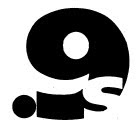TTAB Reverses 2(d) Refusal of "S9" Over Stylized ".9S" Mark for Computer Goods
The Board reversed a Section 2(d) refusal to register the mark S9 in standard character form, for network access gateways, finding it not likely to cause confusion with the mark shown immediately below, for "computer systems comprised of computer software and hardware for communications systems security, traffic and bandwidth management." The differences in the marks coupled with the care with which the goods are purchased outweighed the fact that the goods overlap. In re GENBAND Inc., Serial No. 77627106 (March 30, 2011)[not precedential].

The Examining Attorney contended that Applicant's mark "could be presented in the same manner of display, and the fact that the registered mark is stylized does not obviate a likelihood of confusion." She argued that there is no "defined order" to the cited mark because of the overlap of the S and the 9.
The Board, however, ruled that Applicant's "standard character form mark S9 does not extend to a display of the mark as '9S.'"
The Board must consider a standard character form mark in "all reasonable manners in which in which applicant could depict its mark." ** The manner in which registrant displays the "9" and "S" in its mark is unusual because the "S" is embedded in the leg of the "9," to the right of the mark.
And so the Board found the marks dissimilar in appearance. It also found the sounds to be different: the cited mark is likely to be pronounced as "dot nines," whereas Applicant's mark is pronounced "es-nine." Neither mark has any particular meaning, and the commercial impressions of the marks differ.
As to the conditions of purchase, the Board agreed with Applicant that the goods would be bought with "some care." The goods "have a considerable cost and [purchases] would not be made without deliberation and input from technical personnel."
Balancing the du Pont factors, the Board found no likelihood of confusion.
TTABlog comment: While I agree with the Board's decision, its statement regarding its obligation to consider "all reasonable manners" in which Applicant's mark could be depicted is in conflict with the recent decision of the CAFC in Citigroup, Inc. v. Capital City Bank Group, Inc., 98 USPQ2d 1253 (Fed. Cir. 2011) [precedential]. There, the CAFC rejected the "reasonable manner" approach:
Neither Phillips nor any other opinion of the United States Court of Customs and Patent Appeals, our predecessor court, or this court has endorsed the T.T.A.B.’s “reasonable manner” limitation of variations evaluated in the DuPont analysis.* * *
The T.T.A.B.’s “reasonable manner” standard limits the range of marks considered in the DuPont analysis. * * * The T.T.A.B. should not first determine whether certain depictions are “reasonable” and then apply the DuPont analysis to only a subset of variations of a standard character mark. The T.T.A.B. should simply use the DuPont factors to determine the likelihood of confusion between depictions of standard character marks that vary in font style, size, and color and the other mark. As explained in Phillips, illustrations of the mark as actually used may assist the T.T.A.B. in visualizing other forms in which the mark might appear.
As I commented when the CAFC decision came down: The court did not make it clear (at least to me) what the TTAB is supposed to do in considering the possible variations of a standard character mark. The Board cannot limit its consideration to "reasonable" alternatives. So must it consider "unreasonable" alternatives?
As to the CAFC indication that the Board may look at "illustrations of the mark as actually used," that is of little help when, as here, that application is based on intent-to-use.
Text Copyright John L. Welch 2011.




0 Comments:
Post a Comment
<< Home